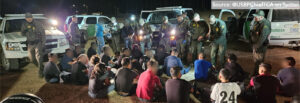With Congress debating a Department of Homeland Security funding bill, the issue of border security is in the spotlight. But while some in Washington quarrel over a nebulous “crisis” at the border, a lesser-known—but in many ways more grim—situation is playing out along a 150-mile stretch of the U.S.-Mexico border, in Texas’s Rio Grande Valley region.
Today WOLA releases a new report, On the Front Lines: Border Security, Migration, and Humanitarian Concerns in South Texas, that graphically illustrates the challenges faced by migrants, law enforcement, and border security officials in this swath of arid ranch lands.
For migrants, the sunbaked and vegetation-dense landscape of the Rio Grande Valley represents a major safety risk. The region now records the highest number of migrants dying of dehydration and exposure, making it the deadliest of Border Patrol’s nine "sectors" along the U.S.-Mexico border. This is a shift from previous years, when the Tucson sector of Arizona saw the most migrant deaths.
The rapid rise in migrant deaths in South Texas caught authorities off guard and, in spite of U.S. Border Patrol search-and-rescue efforts, much of the burden to mitigate deaths and to handle and process remains has been unfairly shouldered by local governments. According to Maureen Meyer, WOLA Senior Associate for Mexico and Migrant Rights, “While Washington is locked in a stalemate, border counties in South Texas are stretched thin and lack adequate federal funding to properly handle migrant remains and identify those who have perished.”
Border Patrol also lacks the resources to make its operations more nimble, and recent events show a greater need for its agents to be deployed more flexibly in order to respond to shifts in migration. “Border Patrol has doubled in size in the past ten years. Nationally, it does not need to grow further—it needs to be able to move existing personnel into the areas that see more border-crossers,” said Adam Isacson, WOLA Senior Associate for Regional Security. “The Defense Department has ample funds for transferring soldiers and supporting them in their new locations. Homeland Security doesn’t. Our civilian Border Patrol agents need similar support when they get transferred, because the U.S. border security buildup means migration patterns are going to keep changing,” Isacson said.
Click here to read the report.
WOLA’s report shows that those migrants who are apprehended in the Rio Grande Valley, meanwhile, face a separate set of challenges. Many Central American families arriving at the border are placed in detention centers that rarely provide adequate access to healthcare and legal representation. Although unaccompanied Central American migrant children are eventually placed with a family member or sponsor while they await their immigration hearing, many face immigration proceedings without legal representation, dramatically reducing their possibilities of being granted some form of relief.
Unaccompanied children from Mexico, by comparison, are not automatically given the opportunity to make their case before a judge. Instead, Customs and Border Protection agents determine whether they are victims of trafficking or persecution, and most are quickly deported, sometimes to the dangerous situations they may have been trying to escape by migrating north.
Texas's Rio Grande Valley sits across from what is today the most violent segment of Mexico’s border zone: the border cities in Mexico’s Tamaulipas state. Although the security situation in Tamaulipas worsened in 2014, this area continued to receive the largest share of Mexican citizens deported by the United States. Migrants deported to Tamaulipas face grave dangers, frequently falling victim to kidnapping, extortion, or even forced recruitment by organized crime.
The WOLA report highlights the need to better address these issues and offers a list of recommendations for Mexican and U.S. authorities to respond more effectively to the reality on the ground, the rapid shifts in insecurity and migration dynamics, and the urgent humanitarian needs of migrants in the Rio Grande Valley.

